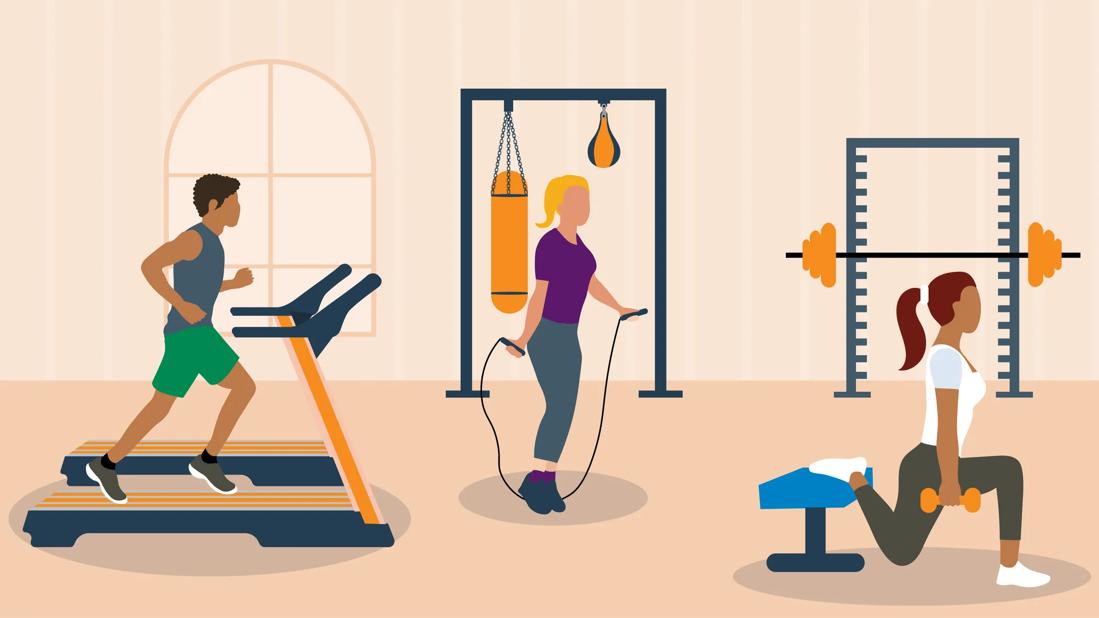The order of your workout matters when it comes to reaching fitness goals

You walk into the gym amped with plans for an epic full-body workout. You’re going to hit cardio AND you’re going to hit weights. But here’s the question: Where should you start?
Advertisement
Cleveland Clinic is a non-profit academic medical center. Advertising on our site helps support our mission. We do not endorse non-Cleveland Clinic products or services. Policy
Going in either order — cardio before strength training or strength training, then cardio — can work, says exercise physiologist Katie Lawton, MEd. But the right answer for you depends on your personal fitness goals.
Why are you working out? The answer to that question can help you determine how to order your exercise routine.
For starters, if you’re not “in training” for something and just plan to hit cardio and strength exercises for general fitness reasons, how you organize a double-duty workout isn’t particularly important.
Each type of exercise works the body differently, but at a basic level:
“For most of us, it doesn’t make a difference which you do first,” says Lawton. “So, if you do some running on the treadmill and then decide you have extra energy for strength training, go ahead and do it. Vice versa, too.”
But what if you’re training for something specific? In general, Lawton suggests the following guidelines:
Advertisement
Let’s break it down.
Start your workout with cardio-based aerobic exercise if your primary goal is to build stamina. This would cover athletes training to run a marathon, pedal through a century ride or compete in a triathlon.
Doing cardio first allows you to sustain your workout effort for longer and increase endurance and performance. “You don’t want to use all your energy on strength training and then start your running or cycling workout,” Lawton warns.
Research shows that your body (and specifically your heart) will be forced to work harder for the same results if you do strength training before an intense cardio session, which can undermine the training effect.
Doing cardio on taxed muscles also increases your risk of injury and lingering fatigue, Lawton notes.
Strength training (anaerobic exercise) asks your muscles to do more than they normally do, a process known as overloading. Lifting heavier weights and/or increasing reps during training is how you build strength.
Beginning a lifting session with fresh muscles is key to maximizing your strength gains.
“If you fatigue your muscles with running or high-intensity cardio before you lift, it will cut into the muscle power you bring to your strength training — and studies show that will limit your workout results,” emphasizes Lawton.
Strength training after cardio also increases your risk of injury, given the demands of lifting.
Can’t decide which to do first when it comes to cardio or strength training? The solution may be to do them both at once.
High-intensity interval training (HIIT) combines the heart-pumping benefits of cardio with the muscle-building aspects of strength training. The workouts are shorter in duration, too, lasting anywhere from 10 to 30 minutes. This makes them ideal if you’re pressed for time.
HIIT workouts include:
Working HIIT into your fitness plan is a good way to add variety to your routine, especially if you’re hyper-focused on one area of training. It can break up the monotony of running mile after mile or pumping iron.
“HIIT training is the best of both worlds, and it can add a lot of interest to your workouts,” Lawton points out.
The healthiest workout routines include both cardio and strength training. “One is not better than the other,” explains Lawton. “Your body needs them both.”
Ideally, your weekly exercise plan should include:
Advertisement
Checking those boxes may require doing cardio and strength on the same day, driving the which-should-go-first question that brings comments and theories to many online message boards.
“Make sure you have the most amount of energy for what you want to focus on the most,” advises Lawton. “That’s the best way to get the gains you’re looking for.”
Advertisement
Learn more about our editorial process.
Advertisement

Lower-intensity workouts can deliver high-quality health and fitness results

Incremental changes in your exercise routine can improve your strength and endurance over time

Understanding heart rate zones can help you tailor your workout to reach your goals

Increase the size of your muscles by bulking up on protein and focusing on slow, intense movements with progressive overloading

Low-impact exercises help you recover faster between sets, during cool downs and on rest days

Eccentric is slow and steady, while concentric is fast and controlled

Weightlifting can help you build muscle mass, reduce joint pain and increase flexibility to improve your quality of life

Abdominal exercises don’t have to be done on the floor!

The ‘sunshine vitamin’ is found naturally in some fish and is added to other foods

Autism and ADHD often go hand in hand, giving rise to the term AuDHD

The Yuzpe regimen is less effective than other forms of emergency contraceptives, and it’s associated with more side effects